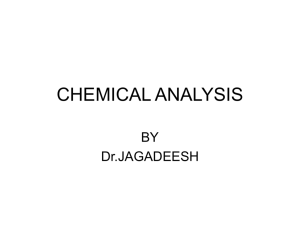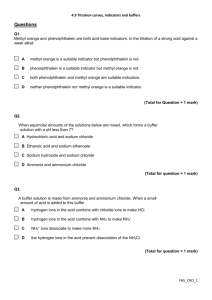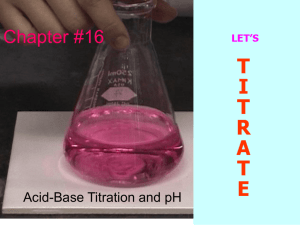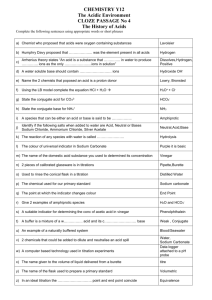File
advertisement
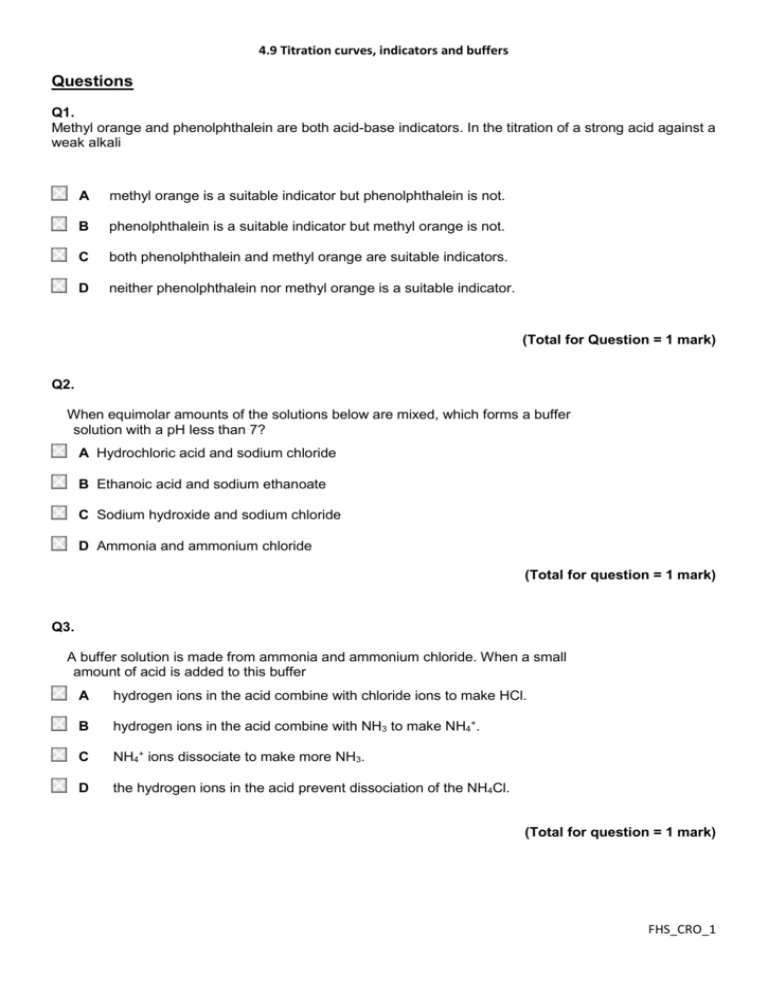
4.9 Titration curves, indicators and buffers Questions Q1. Methyl orange and phenolphthalein are both acid-base indicators. In the titration of a strong acid against a weak alkali A methyl orange is a suitable indicator but phenolphthalein is not. B phenolphthalein is a suitable indicator but methyl orange is not. C both phenolphthalein and methyl orange are suitable indicators. D neither phenolphthalein nor methyl orange is a suitable indicator. (Total for Question = 1 mark) Q2. When equimolar amounts of the solutions below are mixed, which forms a buffer solution with a pH less than 7? A Hydrochloric acid and sodium chloride B Ethanoic acid and sodium ethanoate C Sodium hydroxide and sodium chloride D Ammonia and ammonium chloride (Total for question = 1 mark) Q3. A buffer solution is made from ammonia and ammonium chloride. When a small amount of acid is added to this buffer A hydrogen ions in the acid combine with chloride ions to make HCl. B hydrogen ions in the acid combine with NH3 to make NH4+. C NH4+ ions dissociate to make more NH3. D the hydrogen ions in the acid prevent dissociation of the NH4Cl. (Total for question = 1 mark) FHS_CRO_1 4.9 Titration curves, indicators and buffers Q4. Which of the following mixtures would form the best buffer solution with pH 9 for use in a school laboratory? A Ethanoic acid and sodium ethanoate B Sodium chloride and sodium hydroxide C Hydrocyanic acid and sodium cyanide D Ammonium chloride and ammonia (Total for question = 1 mark) Q5. Which of the following mixtures would form the best buffer solution with pH 5 for use in a school laboratory? A Ethanoic acid and sodium ethanoate B Hydrochloric acid and sodium chloride C Sodium hydroxide and sodium methanoate D Ammonium chloride and ammonia (Total for question = 1 mark) Q6. Which one of the following indicators is most suitable for titrating ethanoic acid with 0.1 mol dm −3 sodium hydroxide? (Refer to page 19 of your data booklet.) A B C D Thymol blue (acid) Bromothymol blue Thymol blue (base) Alizarin yellow R (Total for question = 1 mark) FHS_CRO_2 4.9 Titration curves, indicators and buffers Q7. In a pH titration, 30 cm3 fo sodium hydroxide solution was added, in 1 cm3 portions, to 20 cm3 of ethanoic acid solution, CH3COOH(aq). The concentration of both solutions was 0.50 mol dm−3. After the addition of each 1 cm3, the pH was recorded using a pH meter. (a) (i) Write the Ka expression for ethanoic acid. (1) (ii) Using your answer to (i), calculate the pH of the 0.50 mol dm−3 ethanoic acid solution before the titration starts. Refer to page 18 of the data booklet. (2) (iii) Deduce the volume of sodium hydroxide solution required to reach the end point. (1) ............................................................................................................................................. (iv) Calculate the pH of the solution after all of the sodium hydroxide is added. (4) FHS_CRO_3 4.9 Titration curves, indicators and buffers (v) On the axes below sketch a graph to show how the pH changes during the titration. (3) FHS_CRO_4 4.9 Titration curves, indicators and buffers (b) An acidic buffer solution can be made by mixing together a solution of ethanoic acid and solid sodium ethanoate. (i) Calculate the mass of solid sodium ethanoate (molar mass = 82 g mol−1) that would be added to 500 cm3 of ethanoic acid, concentration 1.0 mol dm−3, in order to make a buffer solution of pH = 4.70. (4) *(ii) Explain how this buffer solution resists a change in pH when a few drops of sodium hydroxide are added. (3) ............................................................................................................................................. ............................................................................................................................................. ............................................................................................................................................. ............................................................................................................................................. ............................................................................................................................................. ............................................................................................................................................. (Total for question = 18 marks) FHS_CRO_5 4.9 Titration curves, indicators and buffers Q8. The bubble bath 'Colour Change Matey' has amongst its ingredients the weak acid benzoic acid, as well as the indicator bromocresol green. When it is added to bath water, its colour changes from yellow to blue. (a) (i) Write the Ka expression for the dissociation of benzoic acid, C6H5COOH. (1) (ii) Use the data on page 18 of the data booklet to calculate the pH of a solution of benzoic acid, C6H5COOH, of concentration 0.0025 mol dm−3. (2) *(b) Use the data on page 19 of the data booklet, and your answer to (a)(ii), to suggest why the bubble bath changes colour when it is diluted by being added to the bath water. (4) ............................................................................................................................................. ............................................................................................................................................. ............................................................................................................................................. ............................................................................................................................................. ............................................................................................................................................. ............................................................................................................................................. ............................................................................................................................................. ............................................................................................................................................. (Total for question = 7 marks) FHS_CRO_6 4.9 Titration curves, indicators and buffers Q9. The titration curves below were obtained using different acids and bases, each with concentration 0.1 mol dm−3. (a) Which curve is produced by adding ammonia to 25 cm3 of hydrochloric acid? (1) A B C D (b) Which curve is produced by adding ethanoic acid to 25 cm3 of sodium hydroxide? (1) A B C D (c) An indicator with pKIn 8.5 is suitable for the following titrations. (1) A Titrations A and B only. B Titrations A, B and D only. C Titration C only. FHS_CRO_7 4.9 Titration curves, indicators and buffers D Titrations A, B, C and D. (Total for question = 3 marks) Q10. Vinegar is used as a food preservative. It is an acidic solution containing ethanoic acid, CH3COOH. (a) A titration was carried out to measure the concentration of ethanoic acid in a sample of vinegar. 25.0 cm3 of a vinegar solution was titrated with a solution of sodium hydroxide, concentration 0.250 mol dm−3. The concentration of the ethanoic acid in the vinegar solution was found to be 0.125 mol dm−3. (i) Calculate the pH of 0.250 mol dm−3 sodium hydroxide at 298 K. [Kw = 1.00 × 10−14 mol2dm−6 at 298 K.] (2) (ii) Write the expression for the acid dissociation constant, Ka, for ethanoic acid. (1) (iii) Calculate the pH of 0.125 mol dm−3 ethanoic acid at 298 K. [Ka for ethanoic acid is 1.7 × 10−5 mol dm−3 at 298 K.] (2) (iv) When half the ethanoic acid is neutralized, the concentration of the remaining ethanoic acid equals the concentration of the sodium ethanoate which has formed. What is the pH of the mixture at this point? Justify your answer. (2) pH ............................................................................................................................................. Justification ............................................................................................................................................. FHS_CRO_8 4.9 Titration curves, indicators and buffers (v) On the axes below, sketch the titration curve for this reaction when 30 cm3 of the sodium hydroxide is added to 25.0 cm3 of the vinegar solution. (3) *(vi) The only indicators which were available for this titration were methyl yellow (in ethanol) and thymolphthalein. Explain which indicator is more suitable for this titration and why the other is unsuitable. You will need to refer to your data booklet. (2) ............................................................................................................................................. ............................................................................................................................................. ............................................................................................................................................. ............................................................................................................................................. ............................................................................................................................................. (b) In the food industry, ethanoic acid is described as an acidity regulator, additive number E260. Ethanoic acid can neutralize alkalis. What substance could be mixed with ethanoic acid so that it regulates pH as a buffer in foodstuffs? (1) ............................................................................................................................................. (Total for question = 13 marks) FHS_CRO_9 4.9 Titration curves, indicators and buffers FHS_CRO_10 4.9 Titration curves, indicators and buffers Q1. No Examiner's Report available for this question Q2. No Examiner's Report available for this question Q3. No Examiner's Report available for this question Q4. No Examiner's Report available for this question Q5. No Examiner's Report available for this question Q6. No Examiner's Report available for this question FHS_CRO_11 4.9 Titration curves, indicators and buffers Q7. (a)(i-ii) Both parts (i) and (ii) were high-scoring with many candidates scoring maximum marks. There were three main errors. The first was produced by a sizeable minority which was determining the pKa rather than the pH because the candidate simply carried out a −log of Ka calculation. This was not acceptable and lost both marks. The second was to omit the square root in the determination of the hydrogen ion concentration. The second mark could still be awarded for a transferred error. The third error was a rounding error giving the pH as 2.53 from a calculated value of 2.535. This did require careful marking because if the hydrogen ion concentration had been earlier rounded up to 2.92 × 10−3 then a pH =2.53 could be awarded both marks. Only if the candidate had clearly shown that this was their process could both marks be awarded. Results Plus: Examiner Comments Candidates should always be reminded to clearly set-out their working when doing calculations and then the marks can be easily awarded. Results Plus: Examiner Tip This is a fine example of the lay-out which demonstrates to the examiner how the FHS_CRO_12 4.9 Titration curves, indicators and buffers final answer is calculated and thus means that there is no hesitation in awarding maximum marks. (a)(iii) A very straight-forward question with the majority giving the correct answer, although a sizeable minority did give answers such as 15 cm3 and 30 cm3. Any units given were ignored unless a candidate had converted the volume into decimetres, which then meant that the units were essential. This was rarely seen however. (a)(iv) The answer to part (iii) was seen with the answer to part (iv) to allow candidates who had used their own value from part (iii), although incorrect, to arrive a pH value in part (iv) and to still score full marks. This was rarely seen but still an important principle to uphold. Consequently this did mean, on occasions, that despite a correct answer in part (iv), full marks were not awarded because it was not the correct 'follow-on' from the candidate's own answer to part (iii). However there were some candidates who very clearly demonstrated that they understood the situation, laid-out their answer and workings in full and who scored full marks in part (iv) from an answer that was not correct from their answer to part (iii) but was the true answer from the mark scheme. It showed that the candidate did grasp the question and had the ability to deduce the correct answer but that they really should have gone back and checked their answers to make them consistent. Results Plus: Examiner Comments Two marks out of four were awarded for this response and it illustrates the advantage of clearly showing how the final answer is arrived at. The hydrogen ion concentration, although incorrect, is determined in the right way from Kw and then the pH value from the hydrogen ion concentration. These two steps were given credit and 2 marks were the outcome. FHS_CRO_13 4.9 Titration curves, indicators and buffers Results Plus: Examiner Comments In this example, the number of moles of NaOH is incorrectly determined as 0.015 at the beginning. Thereafter the calculation is carried out correctly and so only 1 mark lost, resulting in this response scoring 3 out of 4. Results Plus: Examiner Tip Within calculations marks are normally awarded after a mistake as a transferred error and so not all marks are lost. Thus a candidate should always show all of their working clearly. (a)(v) This question was generally answered well with the vast majority scoring at least one mark. The initial and final pH values were important for the first mark and this was the most common scoring point. Generally an 's-shaped' curve was drawn but the vertical section should only be between 3 and 5 units in length, otherwise a strong acid-strong base curve is suggested. This was the marking point most often lost. The vertical section needed to be seen at 20 cm3 and this was often awarded. FHS_CRO_14 4.9 Titration curves, indicators and buffers Results Plus: Examiner Comments One mark is lost for an incorrect vertical section at 15 cm3. However marks were awarded for the start and beginning points being within the suitable ranges expected and the vertical section was within 3-5 units in length. Results Plus: Examiner Tip Care obviously does need to be taken when drawing a sketch, especially under the stress of an examination. One mark is nearly lost here because at the start of the curve on the left hand side it almost decreases in pH. A decrease would have been penalised but this was given the benefit of the doubt. (b) FHS_CRO_15 4.9 Titration curves, indicators and buffers In part (i) there were two possible approaches to answering the question, one using the Ka equation and the other using the pKa equation. Both were seen although the Ka route was much more common. Full marks were scored using either method and this question generated the full range of marks depending on the ability of the candidate to answer this type of calculation. In part (ii) the marking point for the reaction of hydroxide ions with the ethanoic acid to make ethanoate ions and water was by far the most common scored. A sizeable minority appreciated that there was a need to state that the buffer contains a reservoir of ethanoic acid molecules but it was rare to see a statement that the concentrations of ethanoic acid and ethanoate remain (almost) constant. This has been examined before on a number of occasions and so should not have been a surprise to candidates. Results Plus: Examiner Comments One mark was gained in both parts of the question. In part (ii) the mark is gained for a description of the combination of the hydroxide ions with hydrogen ions to make water and then the further dissociation of the ethanoic acid. This could have been more easily gained from the equation. Results Plus: Examiner Tip If a candidate is very unsure how to proceed with a calculation then, rather than leave the space blank, they are always best advised to 'do what they can'. This is an example of that approach in (b) because the candidate clearly doesn't know how to calculate the mass of the salt required for the buffer but can determine the hydrogen ion concentration from the pH. This is worthy of credit and scored one mark. FHS_CRO_16 4.9 Titration curves, indicators and buffers Results Plus: Examiner Comments A high-scoring response with 4 marks for (i) and 2 marks for (ii). In part (ii) no reference is made to the ratios of ethanoic acid and ethanoate concentrations remaining (almost) unchanged but instead that the pH is constant which is in stem of the question. FHS_CRO_17 4.9 Titration curves, indicators and buffers Results Plus: Examiner Comments Marks are always awarded wherever possible and one mark was given for arriving at a final mass of salt by multiplying by the given molar mass of 82 g mol−1. One mark was also given for determining the hydrogen ion concentration from the pH value although sadly no use was made of it. FHS_CRO_18 4.9 Titration curves, indicators and buffers Results Plus: Examiner Tip In part (ii) reference is made to the shifting of an equilibrium but there is none shown in the answer. It is true that there is an equilibrium equation in part (i) but candidates are well advised to make sure in their answer exactly to what they are referring. (a)(i) Candidates of all abilities were able to score on this question. It was only 'careless' slips such as the omission of a charge that meant the mark was lost Results Plus: Examiner Comments An example of a correct response. (a)(ii) Most candidates were correctly able to calculate pH and to score 2 marks. The occasional arithmetical error was seen. Results Plus: Examiner Comments An example of a correct answer. (b) Only the more able candidates could correctly describe why the colour changes occurred. FHS_CRO_19 4.9 Titration curves, indicators and buffers Most responses did include the requested pH range for the indicator and then state the addition of bath water diluted the acid so that the concentration of the H+ ions decreased. A logical stepwise approach to this type of question is always recommended. The colour is yellow to begin with because of the low pH from part a(ii) which is below the pH range of the indicator. Then the colour changes to blue when the pH goes above the range (5.4). References to green were not given credit because the colour changes in the question were from yellow to blue. Results Plus: Examiner Comments A reminder to make sure that a response includes the 'easy' mark. Here the question requests the data from page 19 of the booklet and this candidate has stated this first to be sure of that mark. There is nothing else worthy of credit here. No Examiner's Report available for this question (a) (i) Calculating the pH of a strong base is less straightforward than calculating the pH of a strong acid, and (a)(i) revealed various misunderstandings. Many candidates thought that the concentration of hydroxide ions was half the concentration of sodium hydroxide. Some used the expression for Ka of a weak acid producing a totally meaningless answer. Others made errors when manipulating the powers of 10 in their calculations. (a) (ii)-(iii) The expression for Ka required in (a)(ii) was well known, though marks were not given for the approximation unless the full version was also given. If an expression was given for a theoretical acid, HA, a key to the symbols HA and A- was required. The principle of calculating the pH in FHS_CRO_20 4.9 Titration curves, indicators and buffers (a)(iii) from the Ka expression with approximations was well known, but actually doing the arithmetic caused difficulties. Results Plus: Examiner Comments This is a good clear answer with correct formulae, square brackets and the calculation in (iii) shown clearly which would therefore have got the first mark even if there had been an error in the final value. (a) (iv) In (a)(iv) the fact that pH = pKa at the point where half the acid has been neutralised in a titration had been learnt by some candidates. Some others worked it out using the Ka expression, but many assumed this occurred at pH 7, forgetting that the acid and base involved were not both strong. Results Plus: Examiner Comments This shows the common misunderstanding about the point where half the acid has been neutralised. (a) (v)-(vi) The titration curves drawn in (v) were very varied. Some were very poorly drawn with several crossings out, falling pH values, thick lines and other assorted errors. The mark gained least often was the one for appreciating that the vertical section of the curve would occur after addition of 12.5 cm3 of sodium hydroxide. The most popular assumption was that it would be half way across the graph at 15 cm3. Though many realised that a strong base was being added to a FHS_CRO_21 4.9 Titration curves, indicators and buffers weak acid, the vertical section sometimes started round pH4 and went up to pH14. On some occasions the pH was shown as still rising very steeply after addition of 30 cm 3 of sodium hydroxide. In (vi), a significant number of candidates did not read the instructions and used their own indicator choice. The question rewarded those candidates who gathered the required information from the Data Booklet and used it appropriately. Though the majority grasped that thymolphthalein would be more suitable, it was apparent that a number did not understand the concept of range of an indicator. Credit was lost by not answering the part of the question which said ".. and why the other is unsuitable", with many explaining why the first indicator was suitable and assuming that it was then obvious why the second was not. Results Plus: Examiner Comments This is an example of a good answer. The only error in the curve is the length of the vertical section. In (vi) the candidate refers to the point of equilibrium rather than FHS_CRO_22 4.9 Titration curves, indicators and buffers equivalence, but the principle that the range of the indicator covers the region of rapid pH change is correct and was given the marks. Results Plus: Examiner Tip Titration curves for strong acid/ strong base have a long vertical section. The vertical section when a weak acid or weak base is involved is shorter. (b) In (b), the most common answer was sodium ethanoate. Candidates may have known that the shape of the titration curve of ethanoic acid with sodium hydroxide is due to the formation of sodium ethanoate, which makes the mixture a buffer. However sodium hydroxide would not be suitable as an additive to foodstuffs in order to produce a buffer, and was not allowed as an answer here. Mark Scheme Q1. Q2. Q3. Q4. Q5. FHS_CRO_23 4.9 Titration curves, indicators and buffers Q6. FHS_CRO_24 4.9 Titration curves, indicators and buffers Q7. FHS_CRO_25 4.9 Titration curves, indicators and buffers FHS_CRO_26 4.9 Titration curves, indicators and buffers FHS_CRO_27 4.9 Titration curves, indicators and buffers FHS_CRO_28 4.9 Titration curves, indicators and buffers FHS_CRO_29 4.9 Titration curves, indicators and buffers Q8. Q9. FHS_CRO_30 4.9 Titration curves, indicators and buffers Q10. FHS_CRO_31 4.9 Titration curves, indicators and buffers FHS_CRO_32 4.9 Titration curves, indicators and buffers FHS_CRO_33
